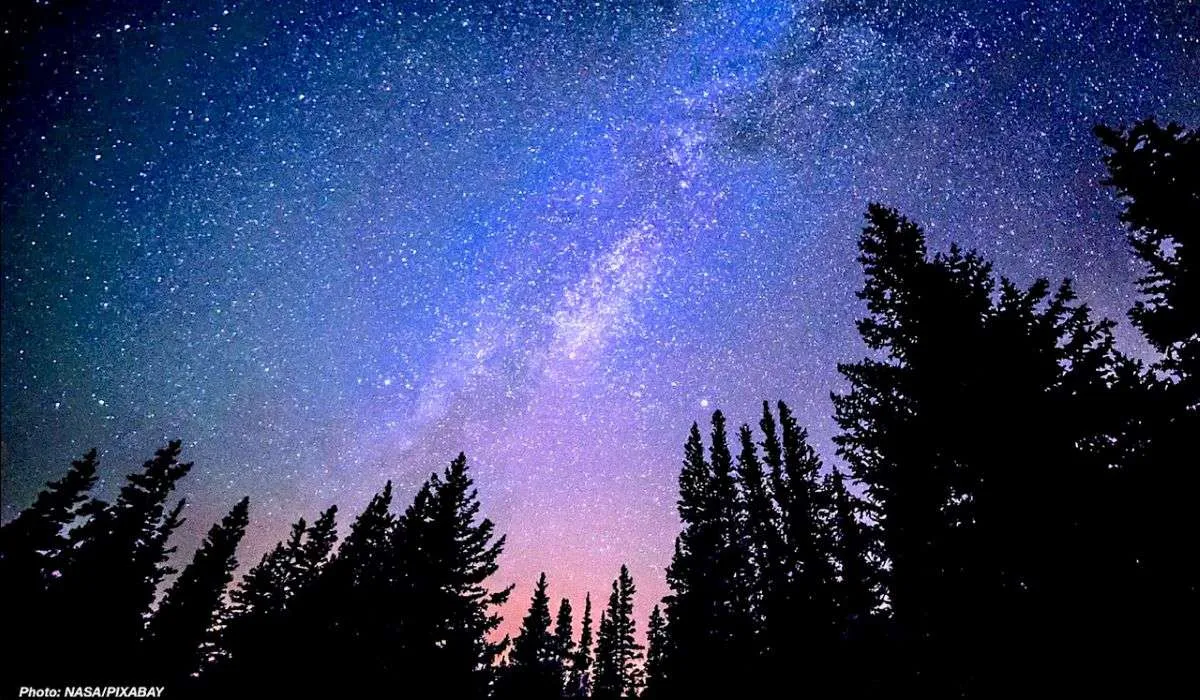Out In the Woods
- June 21st 2024
- Out in the Woods

El Gordo galaxy cluster
Photo: NASA, ESA, CSA, and STScI
Even in Urban Sanford, Dark Skies Can Be Appreciated
By Kevin McKeon, Maine Master Naturalist
On the first night of an Outward Bound team building wilderness camping trip in Maine, one of the teenaged group’s girls was found staring up to the skies with tearful eyes. My granddaughter asked what was wrong. Well, this gal had never before seen such a star-filled sky and was overcome with emotion from the awareness of the awesome beauty above her. She was from an urban city environment where artificial lighting, buildings and indoor living were the norm.
We would do well to wrap our heads around those emotions as we consider that Sanford, even though a city, has places where such dark skies can be appreciated. In the Sanford area, Hanson and Shaw’s Ridges will easily show the glow of artificial light. So seek out spots where the surrounding horizon is blocked by trees, and an opening in the forest canopy is large. The “Fishing Rock” at Deering Pond near the rail trail is good, as is the meadow at the McKeon Reserve and the high meadow/former logging yard at the Three Rivers Land Trust Community Forest.
Artificial light surrounds our typical life. As the result of the “Shifting Baseline Syndrome” effect, the scope of light pollution has crept up on us, relatively unnoticed. Over 80% of the world’s population lives under a “lit sky” — closer to 99% in Europe and North America—and it’s increasing globally by over 2% per year. Light pollution’s deleterious impact on bird migrations generated a United Nations “Dim the Lights for Birds at Night” effort, as part of its Convention on the Conservation of Migratory Species of Wild Animals. This 2022 UN global campaign highlights the need for international action to reduce light pollution. And as we all know, global actions begin with you and me, in our backyards.effort as part of its Convention on the Conservation of Migratory Species of Wild Animals. This 2022 UN global campaign highlights the need for international action to reduce light pollution. And, as we all know, global actions begin with you and me, in our backyards.
Nature’s world is dark half of the time, and creatures have evolved throughout the ages to perform all of their survival needs during various times of day, under various shades of sunlight. Patterns of feeding, sleeping, hiding, migration, hibernation, and reproduction have become dependent upon the circadian rhythm, and the defining element of circadian rhythm is the light/dark cycle. Circadian rhythm is the 24-hour time period during which organisms recognize, anticipate, and use changes in their environment – mostly light levels. They prepare and use their various survival tactics, like finding food and shelter, avoiding predators, mating, and getting rest. Organisms optimizing these tactics have survival advantages, so capitalization of daily light levels is paramount for species’ survival and procreation.
Enter artificial-light streetlights, driveway lights, porch lights, landscape lights, vehicle lights, business lights, security lights, and on and on. All this lighting affects the environment in unnatural ways, disrupting the natural biological processes entrained within the circadian rhythm of all creatures, including humans.
Disruption of circadian rhythms results in unnatural “time shiftings” of creatures’ various survival activities. Feeding times may shift to times when food is less plentiful and/or predators are more prevalent. Reproductive processes like the release of pheromone attractant shift to when the opposite sex is unavailable or non-responsive. Sleep/rest times become erratic, causing high levels of stress, a lowering of health levels, and shorter lifespans. Activity triggers may get muffled, causing delays and/or advances in migratory actions, resulting in arrivals that no longer coincide with usually available food sources or nesting sites.
A good example of the influence of artificial light upon species survival is your porch light. See all those insects flitting about that light? They’re supposed to be in another place, feeding and pollinating their normal food sources and becoming food for other creatures. But they’re doomed to flit about, depleting their energy stores and falling, exhausted, to the ground. By doing that, they are not feeding other creatures, like bats, whip-o-wills and owls, nor are they pollinating food and flowers, thus disrupting the entire ecosystem.
So, what can you do about it? Maybe turn off those night-time lights that are not really needed. Or consider motion-detecting lighting and other options suggested here that are more environmentally friendly to our night-time creatures.
Become awestruck again with the brilliant dark skies above you – like the city girl!






